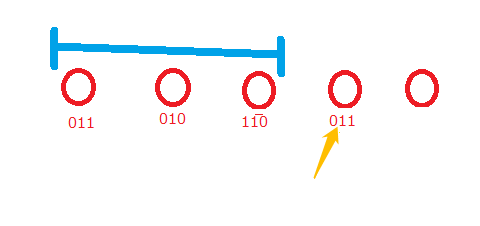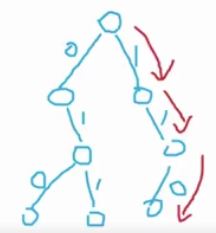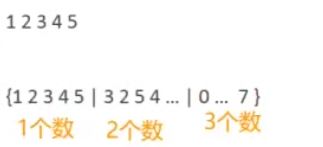口诀:相同为 $0$,不同为 $1$
异或的性质:
- 位运算,不同位之间不影响
- $x \oplus 0 = x$
- $0 \oplus x = x$
最大异或
给定 $n$ 个数,要求你从中选出两个数,使得它们异或最大
分析:
暴力:枚举第一个数,然后在其左边找出与其异或值最大的那个数,复杂度为 $O(n^2)$
加速:在确定了第一个数的位置时,快速计算第二个数的最优选择
考虑固定一个数 $x$,然后把它左边的所有数建 Trie树 (字典树)

从高位到低位贪心:尽可能取与 $x$ 的二进制表示中相应位相反的数,把它与 $x$ 异或一下更新答案

再把 $x$ 加入到 Trie树 中,黄色箭头向后移动,然后做之前类似的操作
C++ 代码
#include <bits/stdc++.h>
#define rep(i, n) for (int i = 0; i < (n); ++i)
using std::cin;
using std::cout;
const int M = 3000005;
int son[M][2], idx;
void insert(int x) {
int p = 0;
for (int i = 30; i >= 0; --i) {
int &s = son[p][x>>i&1];
if (!s) s = ++idx; // 创建新节点
p = s;
}
}
int query(int x) {
int res = 0, p = 0;
for (int i = 30; i >= 0; --i) {
int s = x>>i&1;
if (son[p][!s]) {
res += 1<<i;
p = son[p][!s];
}
else p = son[p][s];
}
return res;
}
inline void chmax(int& x, int y) { if (x < y) x = y; }
int main() {
int n;
cin >> n;
int ans = 0;
rep(i, n) {
int a;
cin >> a;
chmax(ans, query(a));
insert(a);
}
cout << ans << '\n';
return 0;
}
异或第 $k$ 大
给定 $n$ 个数,求他们随意异或(任意多数)所能够得到所有数中第 $k$ 大是多少?

结论1:
将 $n$ 个数中任意数替换成它与其他若干数的异或,生成集合不变
$[x, y, z]$ 生成 $[x, y, z, x \oplus y, y \oplus z, x \oplus z, x \oplus y \oplus z]$
$[x, y, z \oplus x]$ 生成 $[x, y, z \oplus x, x \oplus y, x \oplus z \oplus x, y \oplus z \oplus x, x \oplus y \oplus z \oplus x] = [x, y, z \oplus x, x \oplus y, z, y \oplus z \oplus x, y \oplus z]$
结论2:
如果 $n$ 个数中某个数可以由其他数异或得到,那么这个数没用
$[010, 110, 100]$ 生成 $[010, 110, 100, 100, 110, 010, 000]$
去重后得到 $[010, 110, 100, 000]$
由 $010 \oplus 110 = 100$,所以可以把 $100$ 去掉
$[010, 110] \to [010, 110, 100]$
数列之异或
结论:
当 $n \% 4 == 1$ 时,$\oplus_{k=1}^n \ k = 1$
当 $n \% 4 == 2$ 时,$\oplus_{k=1}^n \ k = n+1$
当 $n \% 4 == 3$ 时,$\oplus_{k=1}^n \ k = 0$
当 $n \% 4 == 0$ 时,$\oplus_{k=1}^n \ k = n$
Code:
#include <bits/stdc++.h>
using std::cin;
using std::cout;
using ll = long long;
int main() {
ll n;
cin >> n;
if (n % 4 == 1) cout << "1\n";
else if (n % 4 == 2) cout << n+1 << '\n';
else if (n % 4 == 3) cout << "0\n";
else cout << n << '\n';
return 0;
}
异或序列
可以按位考虑
我们可以先预处理出前缀异或和 $S_i$,对于区间 $[l, r]$ 的异或值就是 $S_{l-1} \oplus S_r$,而这等价于 该位上有多少个区间的异或值等于 $1$,我们可以统计出 $S[0 \cdots N]$ 在该位上有多少个 $1$ 以及多少个 $0$,二者的乘积就是这一位对答案的贡献
Code:
#include <bits/stdc++.h>
#define rep(i, n) for (int i = 0; i < (n); ++i)
using std::cin;
using std::cout;
using std::vector;
using ll = long long;
int main() {
int n;
cin >> n;
vector<int> a(n);
rep(i, n) cin >> a[i];
vector<int> s(n+1);
rep(i, n) s[i+1] = s[i] ^ a[i];
ll ans = 0;
rep(b, 30) {
int odd = 0;
rep(i, n+1) odd += s[i]>>b&1;
ans += (ll)odd * (n+1 - odd) << b;
}
cout << ans << '\n';
return 0;
}


干脆记成”不进位加法“就好了